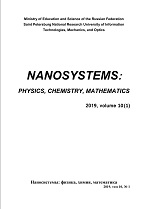|
PHYSICS
Magnetoelectric effects theory by heisenberg method based on permutation group symmetry of nanoparticles
S. Leble
Immanuel Kant Baltic Federal University, Institute of Physics,
Mathematics and Informational Technology, Russia, Kaliningrad 236000
Abstract:
The Heisenberg theory of ferromagnetism is widened to include external electric field action. The material relations are derived by means of differentiation of logarithm of partition function with respect to the magnetic and electric fields. The mean energy coefficients as the exchange integrals combinations are expressed via characters of irreducible representations of corresponding permutation groups by the Heitler method. The thermodynamic equations of state for polarization and magnetization, as functions of the electric and magnetic fields, are derived and illustrated by figures. The magnetization and hysteresis curves in magnetization — magnetic field components plane are built. The theory is applied to nanoparticles, the particle partition function is modeled as the product of the surface and bulk parts. The statistical sum is constructed having explicit expressions for the mean energy in terms of exchange integrals and number of closest neighbors for surface and bulk atoms. The relative contribution of the surface and bulk terms is evaluated.
Keywords:
multielectron states, permutation group symmetry, mean energy, Gauss distribution, Heisenberg chain, electric field, nanoparticles, multiferroics.
Received: 20.01.2020
Citation:
S. Leble, “Magnetoelectric effects theory by heisenberg method based on permutation group symmetry of nanoparticles”, Nanosystems: Physics, Chemistry, Mathematics, 11:1 (2020), 50–64
Linking options:
https://www.mathnet.ru/eng/nano498 https://www.mathnet.ru/eng/nano/v11/i1/p50
|

|




 Contact us:
Contact us: Terms of Use
Terms of Use
 Registration to the website
Registration to the website Logotypes
Logotypes








 Citation in format
Citation in format 